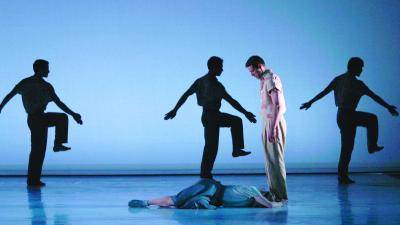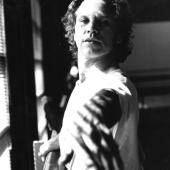FRACTURE: IN/EX DANCE PROJECT, INVERTIGO DANCE THEATRE , METHOD CONTEMPORARY DANCE, LEONIX MOVEMENT THEATRE and STRING THEORY Thursday September 16, 2010 at The Ford Amphitheatre
The Ford Amphitheater continued with its wide ranging summer festival of dance on September 16th with FRACTURE, featuring four Los Angeles dance and theater companies along with the music performance ensemble, STRING THEORY. It turned out to be much more than your usual multi-company mixed bill. In fact, it was an ocean going evening of premieres for dance and music. And while the evening of performances both inside and outside the theater acknowledges the collective effort of those involved, give credit to Jones Welsh of LEONIX for his nimble direction of a very complex program which played to an enthusiastic audience and a mostly full house. The program was a year in the making and a high-water mark for the Ford in its support for programming Los Angeles dance companies on its summer series.
Fronting the evening on the Ford plaza and in a brief prologue in the theater were comedy companies TEN WEST and THE DINGBAT SHOW in sketches of clowning and physical theater, some of which pressed the audience for some involuntary cooperation. The performers in the two companies under the direction of LEONIX were Stephen Simon and Jon Monastero for TEN WEST and Tina Groff and Matthew Morgan for DINGBAT. The clever physical comedy proved a good first course for the evening.
Each of the companies presented its own version of the fracture concept choosing to create dance that takes apart an idea, a feeling or movement itself. IN/EX presented Proof That a Body Was Here which delved into the medical world and altered bodies. The choreography was by founding company members Maya Zellman, Ally Voye, Eva Wilder and Sarri Sanchez all of whom danced in the 17 member ensemble. The opening tableau, a pile of bodies with a standing woman removing surgical gloves leaned heavily on theater and high concept choreography while other sections offered athletic dance movement to carry a piece which at times seemed to lose its way on the small stage crowded with too many dancers. Unison sections were well made, especially one using a prominent cello accompaniment. Jeremy Hale and Marina Magalhães were excellent in a compelling duo with fierce turns and whipping legs. Suzy Myre was also exceptional in a flashing solo moment of repeated turns which gave remarkable momentum to the closing. Lighting designer Jen Goldstein provided stark effects with lighting and video projections using the dancers costumes as a partial screen. Costumes, redesigned scrubs, were by Emily Virgil and helped in unifying the thematic context. The prerecorded score was composed by STRING THEORY founding member Joseph Harvey, with Julie Pusch and Theo Mondle.
INVERTIGO's WreckTangle offered a play on words as well a pieced together gloss on familiar situations such as social dancing, ballet and dance making itself. Much of it comes across with real wit and humor. Choreographer Karlin in collaboration with the company members gave us, if not exactly a story, at least real characters who evolve throughout the piece with changing situations. At the outset we see one dancer being arranged in poses by two women. The two are at odds about how it should go and the dancer suffers along with their suggestions as she is forced into one pose after another. Throughout, whatever the situation, actions and outcomes tend to breakdown -- but never tragically. The piece, in eight sections, is beautifully supported by composer Danny Moynahan's score and a live onstage ensemble of STRING THEORY regulars. They offered clear transitions and a perfect musical environment for WreckTangle to work its peculiar theatrical charm. Especially vivid was an extended tango and Latin groove which was subtle and gave us a musically fractured take on a familiar sound. Other musicians were Toby Karlin on sax, Najeeb Sabour and Joseph Harvey on cello, Holly Rothschild on percussion, Luke Rothschild on guitar and percussion and Moynahan on flute, sax and the non-novelty saw, played as a real instrument. Costuming by Kharen Zeunert was brilliant and provided both rich visual accompaniment and a way to keep the characters identified. Her full blue skirts with black and white bodices were the evenings high fashion moment. Other costumes included a fanciful floor-length patchwork tutu for the ballet-wannabe girl and dashing white vests for the two men. Everyone looked swell. WreckTangle evolves with mostly familiar contemporary movement designed more for the situations at hand than to impress with virtuosity though some satisfying moments of flight occurred with big jetés from the stage's upper level. The effective ensemble cast included Louie Cornejo, SaraAnne Fahey, Sofia Klass, Jodie Mashburn, Mary Tarpley and Kim Thompson. Lighting was by Jen Goldstein.
Closing the program was METHOD CONTEMPORARY DANCE with choreography by Artistic Director Bradley Michaud and company dancers. Michaud's telomere pursues the fracture theme with a powerfully conceived burst of reckless movement meant to expose the ticking time bomb within us as cells divide and in doing so finally run out of reproductive steam. It is a provocative theme and METHOD uses it to great effect in this relentless work. Not only do individual dancers crash to the floor from exhaustion but so do whole groups. Even the movement phrases themselves bottom out, running down like a windup clock only to be powered up by a new wave of energy. METHOD has a style and power that is distinctly urban and confrontational. Their brand of visceral, body-pounding virtuosity played well in the wide open spaces at the Ford where the hillside, upper level and main stage were all used to great effect.
It is easy to love METHOD because they seem to risk so much in conveying their personal vision of dance. Not for them, stories, theater or set inducing costuming; what you do get is a highly distilled and volatile cocktail of precarious, cantilevered movement. The ensemble sections are spectacular because so much happens, and so fast. The bodies become projectiles and that sound you hear is not just the sound score but action calls from the dancers and the dancers themselves hitting the deck. Gone are the quiet landings of yesteryear, folks, this is combat.
telomere opens slowly on the hillside as single dancer, Jessica Harper, appears, caught in bright lighting. Others join and gradually move to the stage's upper level before finally claiming the main stage area. The cast included Jay Bartey, Kalani McMannus, Chelsea Asman, Nicole Cox and Michaud. Rather than individual sections you have an evolution of movement as different combinations and groups come to the fore and then recede. I liked one section on the upper stage level where the dancers seemed briefly caught against a stone wall. You could imagine a firing squad as they are flooded in a hot white light. In another section a group of three dancers, slumped to the floor, power up by rising backward in a unison slow motion; it gives you the impression of film running in reverse. There is no gender discrimination in this world. Uniform costuming put men and women on equal footing. The piece comes to a precipitous close and the stage goes dark in an instant. It is a fitting conclusion -- the sudden cessation of everything.
Special applause goes to STRING THEORY for providing a grinding and shattering sound score that was perfect for telomere. They just may have distinguished themselves as the new go to ensemble for new music for dance in Los Angeles. Their untitled score, which verged on the frightening, was by ensemble founders, Holly and Luke Rothschild. Lighting designer Kristie Roldan covered the vast reaches of the hillside and stage with hot, targeted lighting and observed exacting cues getting it done. White tank tops, calf length dark pants and sneakers helped create a phalanx of dancers who remained more or less anonymous. telomere was short but powerful; you should see it if it comes your way again.
Clever transitions using the huge panels of white fabric that originally masked the stage allowed each company a moment to claim a fresh start. In the midst of the finely tuned FRACTURE, there seemed to be nearly as much coming together as coming apart. The summer series continues with performances in September and October.




